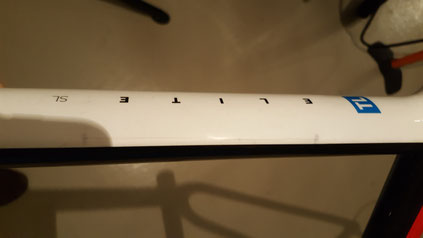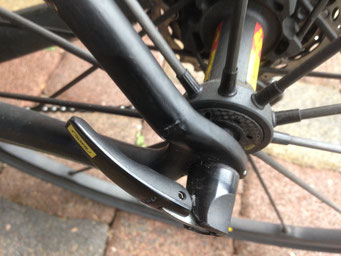Small crack, quirk or defect on the carbon frame - how to assess?
From the myth carbon can not be repaired

Carbon fiber is the raw material with the greatest potential for lightweight construction on the market and thus only as much material is processed as is necessary for the specific application and does not include the steering deflection on the top tube and does also not include a similar impact of a different kind.
Carbon is a material that depends on the axial direction of the fibers (anisotropic), which is decisive for the performance. In comparison, metallic materials have the same properties in all directions (isotropic). A broken, destroyed carbon fiber is much more crucial than a quirk on a metallic bicycle frame.
The material properties of carbon, fiber composites in general, are defined at the micro level in the manufacturing process, the main factors are fiber orientation, fiber specification and the choice of matrix. From this it is easy to deduce that even a smaller fracture leads to a considerable damage to the overall construction. Compared to metallic materials, which consistently have the same material properties in all directions.

If there is little damage, differentiate between scratch, tear / cut and paint chips, depending on the pulse strength and the impact angle. Likewise, the location is crucial for an assessment, defect at the pipe, at the junction, whether dropouts or bottom bracket knots (link only in German, June 2019). If the material background of the scratch is not black (for clearcoats it would be white - white breakage), this indicates a paint scratch. If the quench goes through to the outermost layer of carbon, or if a large-scale paint splintering is to be seen, structural damage is probable.
As a simple test for anyone is recommended the "high-tech thumb-print test": If the tip is under pressure a little more, compared to the adjacent material, then there is a serious damage, and should be repaired immediately.

This is by no means the death sentence for a carbon frame. The broken fiber definitely fails, and the surrounding fibers have to take over "their work". With further use, this leads to a gradual overloading of the adjacent fibers and thus to delamination (detachment of the individual carbon layers from one another). The damage increases creeping by other kilometers with the accompanying vibrations and shocks, but is not visible from the outside, SO BEWARE !!! The myth of the sudden failure of carbon is not sustainable.
For the medium to long-term driving safety, an immediate repair (link only in German, June 2019) is the best solution. The defective fiber and accompanying localized delaminations are grounded, reclosed with fresh laminate and bridged, and worked to the original contour (no additional material application!) Technically, this is a full repair and equivalent to the execution of junctions, nodes in the monocoque construction.

The rating also dependents crucial on the location of the defect. Often it comes in the bottom bracket knot (link only in German, June 2019), the most loaded point on the frame, by the immense driving and twisting forces to minimal paint cracks, carbon is stiff, but not infinite. This should not be overstated, but also not be forgotten. For more information about cracks in the bottom bracket area click here (link only in German, June 2019).

Another peculiarity for cracks is the passage in the transition from dropout to seat or chainstay. If there is a transverse tear at the mentioned point this is usually not a dramatic thing that can be solved with a simple repair. These are stress and vibration cracks in the transition between two components, which were glued together. Often the dropout is made separately, whether made of carbon or aluminum, and is glued to the seat and chainstays. Long-term vibration can lead to cracking of the hard, brittle bond.
If the crack, defect was caused, by a coarser fall or other obvious damage, a non-destructive examination (link only in German, June 2019) is generally advisable. Because not all damage must be visible. In the case of minor damage, no immediate breakage of the frame is to be expected, but the cause is the starting point for a creeping failure, which then "only" apparently leads to a sudden total failure of carbon structures.
Comparing bicycle frames made of carbon with steel or aluminum frames, the latter are less sensitive to damage, but if serious damaged, the repair of a carbon frame is much easier and without restrictions for future use - after the repair you have an equivalent frame.
Share with friends
Start your request help(at)carbon-bike-service.eu via e-mail or via online form on our CONTACT page.


